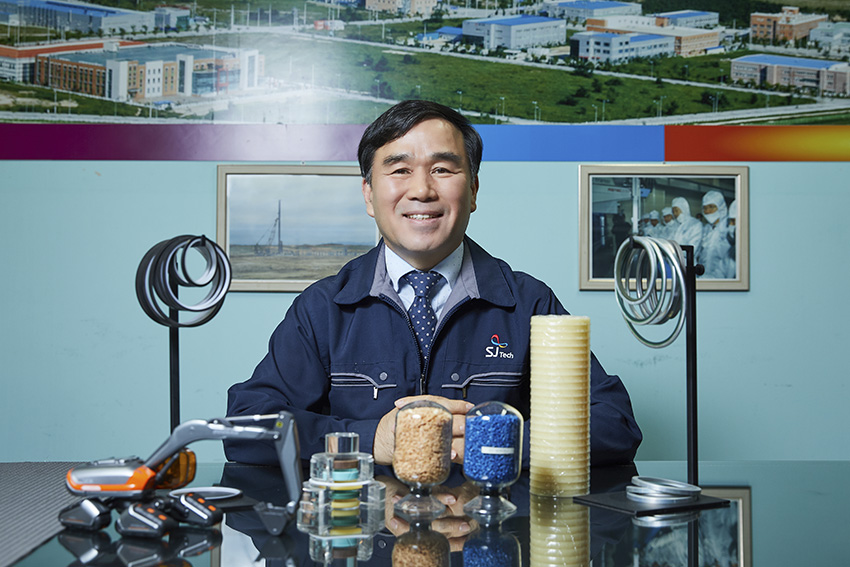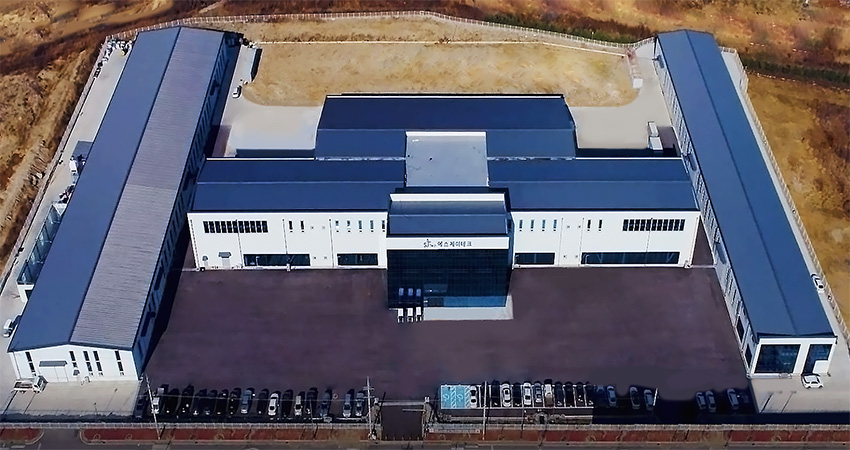Through collaboration with academia, SJ Tech is bringing innovative battery pack technologies for construction equipment and shipbuilding into mass production.

How can SMEs better diversify their client base and reduce their dependence on Korean MNCs?
It's akin to navigating a double-edged sword, often dubbed a nutcracker scenario, where smaller entities find themselves sandwiched between industry giants. Undoubtedly, the presence of these colossal players has exerted pressure on smaller enterprises. However, it has also served as a catalyst for the global expansion of Korean MNCs. I believe the symbiotic growth of both small and large corporations is intrinsic to the Korean economy.
Our journey began as a supplier to Samsung's semiconductor division. When the 1997 Asian financial crisis struck, we transitioned into a corporation and ventured into the domestic market under our indigenous brand. In Korea, SMEs can be categorized into two groups: those heavily reliant on MNCs and those, like us, who have weathered multiple crises, such as the 1997 Asian financial crisis and the 2008 global financial crisis, to establish our presence independently. While it may appear that MNCs monopolize the Korean economy in terms of volume, many SMEs have consciously chosen to distance themselves from dependency on conglomerates, thereby striking a delicate balance between these giants and our own brands.
What opportunities does the global realignment create for Korean companies? How well positioned is Korea to benefit from these strategies?
Last year, at the behest of the US Embassy in Korea, we conducted a market survey in the US and established an e-mobility hub in California. This serves as a pertinent case study. What struck me during my visit to the US was the presence of Chinese businessmen, despite US officials openly stating that the realignment of supply chains aimed to reduce reliance on China. Korean companies find themselves in a quandary as many have invested in the Chinese market, particularly in the battery and semiconductor sectors. However, the US IRA prohibits Korean businesses from operating in China. The overarching global trend indicates a shift in China's role from being a hub for outsourcing to a nation promoting value-added products, thereby enhancing indigenous competitiveness. Consequently, numerous companies are relocating production facilities from China to Vietnam or Mexico. While the US frames the IRA as a reshoring initiative, it's Mexico and Vietnam that reap the benefits of production relocation. Like many Korean firms, we have shifted our production to these regions and are preparing for further relocation to Mexico to facilitate smoother business operations with the US.
Korea's R&D spending accounts for 5% of its GDP, positioning the country at the forefront among the largest manufacturing nations, surpassing Japan and Germany. From your vantage point, how does the Korean ecosystem foster opportunities for manufacturing SMEs and SJ Tech to enhance their competitiveness?
Our company operates as an R&D-focused entity under the auspices of the Ministry of Trade, Industry and Energy. We boast exceptional infrastructure, including state-of-the-art laboratories, alongside collaboration with over 1000 professors. This synergy between industry and academia is pivotal. Notably, 40% of our workforce comprises undergraduate or graduate students, showcasing our commitment to providing educational opportunities. R&D serves as a cornerstone for our company's growth. We cultivate a talent pool through dedicated training programs, supported by an internal venture team consisting of 20 personnel. Moreover, senior employees are encouraged to assume roles as professors at universities, contributing to society by imparting knowledge to startups and fostering skilled manpower within the industry. This commitment underscores our dedication to societal advancement and knowledge dissemination.
Could you elaborate on your expertise in applying new technologies, such as IoT, for smart factories and within your battery business? How do you envision these advancements shaping your portfolio?
Our business model stands out due to its uniqueness. While proprietary technologies are typically developed by national research institutes, we take these innovations and apply them directly in practical settings. Essentially, we serve as a testbed for such original technologies, mass-producing and commercializing them into our products. Think of our company as an R&D-focused entity geared towards production. When we manufacture prototypes, we either offer them to startups or incorporate them into our local brand.
Our survival strategy extends beyond traditional manufacturing processes; we aim to integrate cutting-edge technologies, such as AI developed by university researchers, and commercialize them for market rollout. Personally, I'm part of the Korea Strong Small Business Association, comprising 2,000 Korean SMEs. We're engaged in a collaborative project called Hidden Champion, inspired by the industry 4.0 concept originating from Germany. Our objective is to propel these enterprises towards smart factories tailored to the Korean context, yielding tangible results.
At our Hoengseong plant in Gangwon province, our team leader is also a university professor, showcasing our collaboration with academia and industry.
I believe Korea's new model for innovation lies in its ability to go global by swiftly responding to changing mega-trends with newfound competitiveness and strategies. This adaptability positions us favorably on the international stage.
You mentioned acting as an incubator and the challenges of achieving mass-market viability, which is indeed a significant hurdle. Reflecting on your company's journey, I can now better grasp your evolution and how you've transitioned into e-mobility. Could you elaborate on the commercial operations of your company, particularly focusing on your e-mobility segment?
Diversifying our product portfolio presents inherent complexities. Producing products A, B, and C entails distinct processes. However, what's crucial is integration and conversion. These elements generate synergy within our innovative business model. Recognizing the importance of change in fostering innovation, we continually revise our organizational structure and provide avenues for self-study and ideation. Moreover, we engage in collaborative product development ventures with global partners. While realizing the fruition of such products may take three to five years post-R&D, we believe they hold immense value, potentially becoming lucrative assets. Despite the challenges associated with high upfront costs in R&D, we remain committed to allocating a substantial portion of our revenue towards research and the development of new technologies. We view this as our survival strategy, essential for our sustained growth and competitiveness.
Often, we observe large companies innovating by developing technology within their core business, which then finds application across various segments or sub-segments. Conversely, in your case, much of the innovation stems from academia, implying that every promising idea is potentially a commercial opportunity. What would you say is one of the most significant challenges you face when attempting to commercialize your R&D? Is it related to economies of scale, or is it about acquiring expertise in human resources? How have you successfully navigated the transition from innovation to commercially successful products?
I believe our primary challenge lies in resource scarcity. Once a technology is developed, its commercialization and transformation into a revenue-generating asset depend on market acceptance and adoption by end-users. We encounter significant hurdles in technology development, particularly when pioneering into new markets due to the prohibitively high costs involved. Consequently, many Korean SMEs, like ours, heavily rely on Korean conglomerates with their abundant resources.
Breaking away from dependence on Korean MNCs is a significant challenge. However, a notable shift within the Korean SME ecosystem is the endeavor to establish independent brand reputations by penetrating the US market. Many Korean SMEs, including our own, have showcased their products at events like CES, aiming to establish sales networks in the US. This strategic move represents our collective effort to gain autonomy and global recognition.
Through your various developments, such as the battery pack or the MEV-200, you've maintained long-standing collaborations with your customers over the years. Now, as you aim to utilize your R&D capabilities to create products for commercial purposes and simultaneously enter the US market, what are the next steps in leveraging your R&D for e-mobility-related products in the US? Are you seeking new partnerships?
Our focus is on autonomous vehicles, as we believe the future of e-mobility is intertwined with autonomous driving technology. AI is poised to lead the charge in this era of autonomous vehicles. To bolster our efforts, we've forged collaborations with seven universities, including Inha University and Seoul National University of Science & Technology, renowned for their expertise in technology development. Our partnership with Inha University centers on autonomous vehicle development, while Seoul National University of Science & Technology is dedicated to advancing battery technology.
With offerings like the MEV-100 and two distinct battery solutions, how significant has the e-mobility sector become for SJ Tech over the years? Additionally, what do you foresee as the primary growth drivers for your company? How do you envision the future trajectory of this business segment?
I anticipate that the e-mobility sector will constitute the largest share of our business growth. The e-mobility industry resembles a comprehensive assembly solution in terms of size, differing substantially from smart factory solutions, which involve parts and materials. However, in terms of credibility, e-mobility demands rigorous verification processes and extensive field testing. Even a single risk or failure can pose significant challenges for our company. Therefore, while e-mobility holds immense potential for growth, it also presents considerable complexities and risks that we must navigate diligently.

The e-mobility sector is experiencing significant demand growth, with two distinct directions emerging: autonomous robots and battery packs. Regarding the battery pack aspect, your target applications range from small-sized vehicles to conventional and hybrid vehicles, as well as heavy industries. What is the core focus of your battery pack technology?
Designing BMS requires sophisticated technology, and we have developed our own proprietary software technology for this purpose. Given the unique physical properties of electronic products, especially in contrast to internal combustion engine components, factors such as electric cable resistance vary depending on battery capacity. Therefore, BMS plays a crucial role in ensuring safety. We have subjected our BMS to extensive real-world verification processes, collaborating with partners in Korea and abroad. Additionally, we're working closely with Hyundai Motors to develop specialized vehicles. Moreover, we're actively engaged in a national project aimed at phasing out internal combustion engines and replacing them with batteries to achieve carbon neutrality by 2050.
In Korea, out of 25.5 million registered vehicles, only around 500,000 are electric vehicles (EVs). Including hybrids, the total number of EVs stands at 1.5 million. Achieving carbon neutrality necessitates a significant increase in the supply of EVs, a goal that cannot be met solely by scrapping internal combustion engine vehicles (ICEVs). Instead, the government plans to replace engines with batteries. We have already developed 37 types of low and high-capacity batteries, aiming to expand our product portfolio in line with this initiative.
Furthermore, we are conducting research in collaboration with the Korea Automotive Technology Institute at an industrial complex located in Jeolla-namdo province in southwestern Korea, facilitated by the platform provided by Mokpo University. This industrial complex, designated by the Korean government, operates under relaxed regulations, enabling us to conduct research and development freely. Our active involvement in this industrial complex underscores our commitment to advancing innovation within the automotive industry.

Caddy cart
With a portfolio comprising 37 types of batteries, which applications are you primarily targeting?
For low-voltage batteries used in small vehicles, we encounter no issues in terms of supply, as they have undergone extensive verification processes and there exists a substantial demand for such batteries. However, with high-voltage batteries, as Hyundai, Volvo, and Tucson—partnerships spanning three decades—embark on electrification initiatives, we are striving to provide batteries for their vehicles.
Regarding low-capacity batteries, we acknowledge that we can't compete with Chinese competitors purely on price. Therefore, as we transition from NCM to LFP batteries, we find ourselves in a less advantageous position in this regard. Consequently, we are focusing more on high-capacity special-purpose vehicles.
Low-voltage batteries operate under 72 volts and don't require significant power, whereas the high-voltage batteries we produce exceed 360 volts, demanding substantial investments and advanced technology. As a Korean SME, we've recognized that we may not be as price competitive as Chinese counterparts in this realm. Hence, our participation in the Jeolla-namdo province industrial complex aims to develop batteries for heavy-duty vehicles. Additionally, we've partnered with Doosan to develop fuel cell batteries.
We've discussed the imperative for SMEs to internationalize. What is your international strategy, not only in terms of revenue, but also in terms of partnerships?
While large automakers worldwide are at the forefront of EV manufacturing, we've identified a niche market in construction equipment, given the prevailing trend of electrification in heavy-duty vehicles. We perceive abundant opportunities in this sector in terms of volume. However, it's crucial to note that complete electrification of construction equipment isn't always feasible; typically, only the driving engines can be electrified while operations necessitate a combination of electrification and hydraulic systems. Moreover, in the shipbuilding industry, the push towards ESG (Environmental, Social, and Governance) management is driving retrofitting efforts to enhance electrification. Thus, our focus extends to these two markets: construction equipment and shipbuilding. Additionally, we are preparing to venture into the mining industry, as stringent environmental regulations concerning diesel and urea make electrification an appealing prospect in this sector as well.
Recently, we secured some orders from Japan, and typically, the construction equipment market is dominated by China and the US. However, as we can't compete solely on price with Chinese competitors, we're aiming to establish a presence in the US and Latin America, using Mexico as a strategic bridge. We're currently in discussions with companies in Chile and Peru, given their vast deposits of raw materials essential for battery production.
Despite the geographical distance between Mexico and Asia, Mexico stands as a significant beneficiary of initiatives like the US Inflation Reduction Act (IRA) and Chips Act, which have led to a notable increase in labor costs. Many automakers are relocating their production facilities to Mexico, making it a prime destination for near-shoring initiatives.
In our experience, doing business in China over the past three decades didn't always ensure the security of our capital. However, in Mexico, there's greater assurance for capital investments. Additionally, with China facing various challenges, we see potential in targeting both the domestic and Mexican markets.
While Korean companies are increasingly eyeing opportunities in India, the US and EU present more favorable business environments. Despite the allure of the Indian market, it doesn't always guarantee the security of capital investment, unlike the US and EU markets. Therefore, our focus remains on leveraging opportunities in the US, EU, and Mexican markets for sustained growth and stability.
For more details, explore their website at https://www.welcometosj.com/en
0 COMMENTS